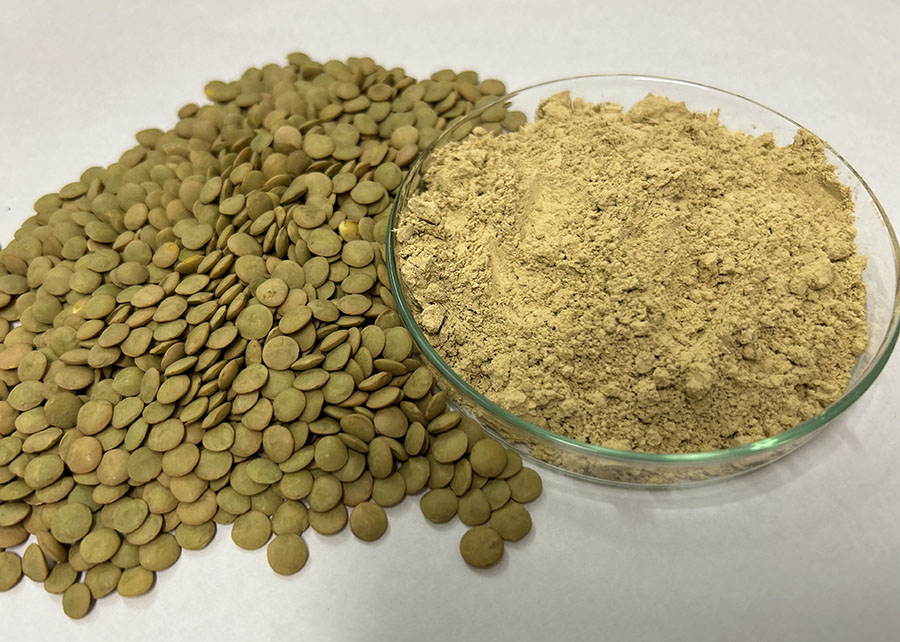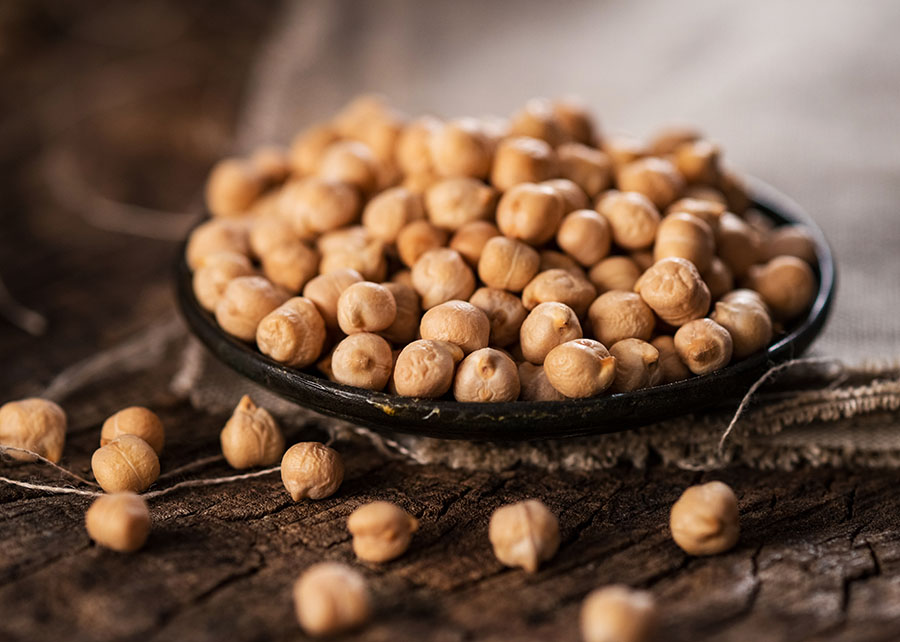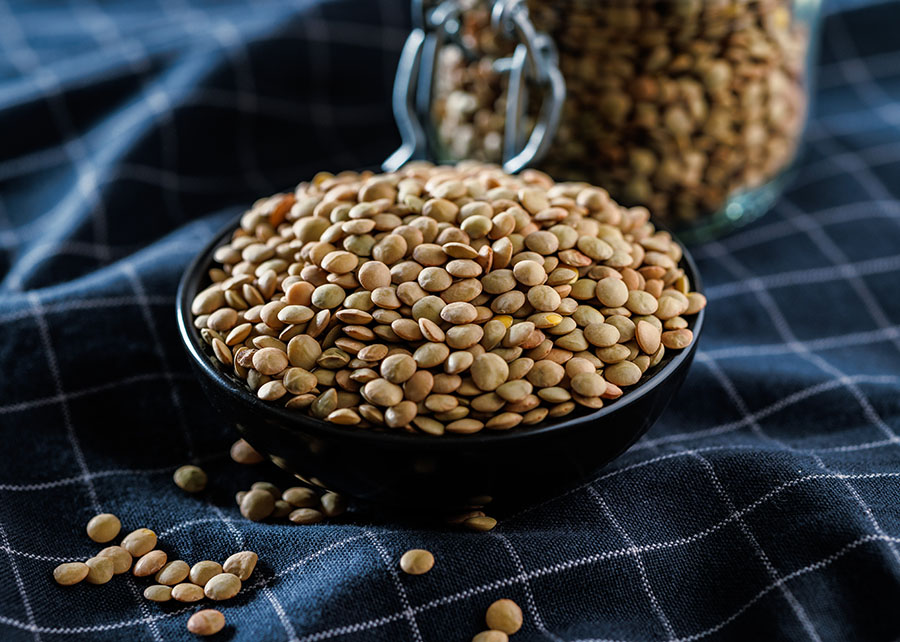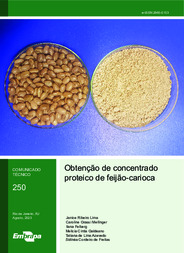The products join the bean protein concentrate, developed in 2023 by the same team of researchers The lentil concentrate presents 80% protein and the chickpea one offers 73%. These technological solutions are options for production in Brazil and alternatives to protein concentrates found in the market, such as the pea one, which is mostly imported. Tests prove that these proteins can be replaced or added to food products, supplements, or beverages. Studies also show that residue from lentil and chickpea protein extraction can be used, reducing the environmental impact of their production Embrapa Food Technology is introducing two new protein concentrates respectively made of lentils and chickpeas into the market, with potential to increase the availability and diversification of ingredients used to produce plant-based foods. The innovations will join the bean protein concentrate developed in 2023 by the same team of researchers, and are also similar to the soy and pea concentrates available in the market. The lentil concentrate presents around 80 g of protein in every 100 g of the product, that is, 80% protein; whereas the chickpea one has approximately 73 g protein per 100 g, which represents 73% protein. The ingredients can add protein content to plant-based foods that are similar to the animal-based ones, such as hamburgers, breaded foods, sausages, plant beverages, and yogurts. They can also be used in baked goods, protein drinks, and dietary supplements, even though they were not developed with the purpose of replacing whey protein. According to the researcher Janice Lima, the research development considered the use of raw materials with reasonable protein content, which is the case of pulses. Pulses are edible seeds in the legume family that are naturally composed of 20% to 30% protein; as they are commonly produced and consumed worldwide, they are strong candidates to obtain protein concentrates. “Those include the pea protein concentrate. Despite being mostly imported, it is known in the market, unlike other legume concentrates. Chickpeas and lentils are crops that have been gathering strength in Brazil due to their production versatility”, Lima observes. Such concentrates are also an option to replace soy-based protein ingredients that are well-known in the market. “The ingredients can be used in foods to improve technological characteristics like increased viscosity, foam stabilization and improved texture, expanding the offer of products aimed at the public of plant-based foods such as vegans, vegetarians or flexitarians”, Lima informs and adds that “the processes to obtain ingredients were developed in the laboratory, and now we are working to reproduce those processes in larger equipment simulating industrial environments”. High protein content The researcher Caroline Mellinger explains that both protein concentrates present high protein content, containing sufficient minimum amounts of part of the essential amino acids in their composition (e.g. lysine, leucine, isoleucine, histidine, and threonine), in accordance with the recommendations of national and international institutions like the Brazilian Health Regulatory Agency (Anvisa) and Food and Agriculture Organization of the United Nations (FAO). “The proteins of both grains were extensively tested in an experiment that simulates human digestion, which is interesting from a nutritional point of view, since the little protein components called amino acids and peptides can be absorbed by the intestines and will form part of protein intake required to keep the human body functioning”, Mellinger affirms. The functionality of proteins can be measured by nutritional, biological, or technological aspects. In the nutritional assessment, the expectation is to obtain large quantities of essential amino acids and assess the protein digestibility of proteins by the human gastrointestinal tract. In the biological perspective, protein action on human health, such as antihypertensive, immunomodulatory, antioxidant activities, among others, are evaluated. Finally, the technological properties assess the protein behavior during the development of products like foods and beverages, that is, if the protein is capable of solubilizing in aqueous media, if it is able to absorb oil or water, and if it forms emulsion or foam, for instance. Lentil and chickpea proteins, similarly to other legumes', are not very soluble in pH values that are close to neutral; however, they form emulsions and foam quite well. “The results show that despite the particularities of each raw material, the developed ingredients are similar to others found in the market, which proves that these proteins can be substituted or added into food products, supplements, and beverages”, the researcher informs. Sensory acceptance The research team carried out sensory analyses with volunteers to verify the acceptance of foods made of the ingredients, which were added to plant-based products resembling the animal-based ones. “There was no difference in the acceptance of the products we formulated with lentil and chickpea concentrates in comparison with the ones we prepared with a commercial protein concentrate. We were very happy with the results achieved, because they reinforce the potential of the concentrates”, the researcher Ilana Felberg states. In laboratory tests, it was observed that lentil and chickpea concentrates have similar characteristics to clean-tasting ones, that is, ones that have neutral taste and hence have less influence in the taste of the final product. Photo: Kadijah Suleiman (chickpea concentrate) Residues can be used The use of the residue resulting from extracting protein from lentil and chickpea grains was also assessed. According to the researcher Melicia Galdeano, who conducted the studies, the objective was to optimize the use of the material based on circular economy practices, a cyclical process that closes all chains. “It is important to highlight that these technologies have less impact in the environment as they do not require the use of chemical reagents that harm the environment”, Galdeano says. As a result, three ingredients were obtained: lentil and chickpea starches with 92% purity; ingredients that are sources of dietary fiber, with 35% content for lentils and 33% for chickpeas; and carbohydrate-rich ingredients (starch and fiber), with 20% fiber for lentils and 21% for chickpeas. All ingredients have potential to be added to diverse processed products for fiber enrichment or as texturizing agents. Publications During the research development, the team at Embrapa Food Technology released publications that offer information on methods to obtain plant proteins. The publication “Guide for technological functional characterization of protein ingredients for the plant-based market”, for instance, aims to standardize the analyzes of plant protein ingredients, which can facilitate the comparison of results obtained by both scientific research and industries. The guide presents a set of methodologies that were adapted and improved for five determinations in plant-protein ingredients: emulsifying capacity and emulsion stability; foaming potential and foam stability; water and oil absorption capacity; water solubility; and gel formation capacity. The publication, which was translated from the original in Portuguese, is addressed to analysis laboratories, industries, and researchers, and it may also be a reference document among professionals in the area. The material aims to help the obtainment of representative and comparable results in each analysis method used, helping to add the plant-protein ingredients to foods.
Photo: Kadijah Suleiman

Os ingredientes possibilitam o acréscimo de teor de proteína a alimentos à base de vegetais que são similares a produtos de origem animal
Embrapa Food Technology is introducing two new protein concentrates respectively made of lentils and chickpeas into the market, with potential to increase the availability and diversification of ingredients used to produce plant-based foods. The innovations will join the bean protein concentrate developed in 2023 by the same team of researchers, and are also similar to the soy and pea concentrates available in the market. The lentil concentrate presents around 80 g of protein in every 100 g of the product, that is, 80% protein; whereas the chickpea one has approximately 73 g protein per 100 g, which represents 73% protein.
The ingredients can add protein content to plant-based foods that are similar to the animal-based ones, such as hamburgers, breaded foods, sausages, plant beverages, and yogurts. They can also be used in baked goods, protein drinks, and dietary supplements, even though they were not developed with the purpose of replacing whey protein.
According to the researcher Janice Lima, the research development considered the use of raw materials with reasonable protein content, which is the case of pulses. Pulses are edible seeds in the legume family that are naturally composed of 20% to 30% protein; as they are commonly produced and consumed worldwide, they are strong candidates to obtain protein concentrates. “Those include the pea protein concentrate. Despite being mostly imported, it is known in the market, unlike other legume concentrates. Chickpeas and lentils are crops that have been gathering strength in Brazil due to their production versatility”, Lima observes.

Such concentrates are also an option to replace soy-based protein ingredients that are well-known in the market. “The ingredients can be used in foods to improve technological characteristics like increased viscosity, foam stabilization and improved texture, expanding the offer of products aimed at the public of plant-based foods such as vegans, vegetarians or flexitarians”, Lima informs and adds that “the processes to obtain ingredients were developed in the laboratory, and now we are working to reproduce those processes in larger equipment simulating industrial environments”.
High protein content
The researcher Caroline Mellinger explains that both protein concentrates present high protein content, containing sufficient minimum amounts of part of the essential amino acids in their composition (e.g. lysine, leucine, isoleucine, histidine, and threonine), in accordance with the recommendations of national and international institutions like the Brazilian Health Regulatory Agency (Anvisa) and Food and Agriculture Organization of the United Nations (FAO).

“The proteins of both grains were extensively tested in an experiment that simulates human digestion, which is interesting from a nutritional point of view, since the little protein components called amino acids and peptides can be absorbed by the intestines and will form part of protein intake required to keep the human body functioning”, Mellinger affirms.
The functionality of proteins can be measured by nutritional, biological, or technological aspects. In the nutritional assessment, the expectation is to obtain large quantities of essential amino acids and assess the protein digestibility of proteins by the human gastrointestinal tract. In the biological perspective, protein action on human health, such as antihypertensive, immunomodulatory, antioxidant activities, among others, are evaluated. Finally, the technological properties assess the protein behavior during the development of products like foods and beverages, that is, if the protein is capable of solubilizing in aqueous media, if it is able to absorb oil or water, and if it forms emulsion or foam, for instance.
Lentil and chickpea proteins, similarly to other legumes', are not very soluble in pH values that are close to neutral; however, they form emulsions and foam quite well. “The results show that despite the particularities of each raw material, the developed ingredients are similar to others found in the market, which proves that these proteins can be substituted or added into food products, supplements, and beverages”, the researcher informs.
 Sensory acceptance Sensory acceptance
The research team carried out sensory analyses with volunteers to verify the acceptance of foods made of the ingredients, which were added to plant-based products resembling the animal-based ones. “There was no difference in the acceptance of the products we formulated with lentil and chickpea concentrates in comparison with the ones we prepared with a commercial protein concentrate. We were very happy with the results achieved, because they reinforce the potential of the concentrates”, the researcher Ilana Felberg states. In laboratory tests, it was observed that lentil and chickpea concentrates have similar characteristics to clean-tasting ones, that is, ones that have neutral taste and hence have less influence in the taste of the final product. Photo: Kadijah Suleiman (chickpea concentrate) |
Residues can be used
The use of the residue resulting from extracting protein from lentil and chickpea grains was also assessed. According to the researcher Melicia Galdeano, who conducted the studies, the objective was to optimize the use of the material based on circular economy practices, a cyclical process that closes all chains. “It is important to highlight that these technologies have less impact in the environment as they do not require the use of chemical reagents that harm the environment”, Galdeano says.
As a result, three ingredients were obtained: lentil and chickpea starches with 92% purity; ingredients that are sources of dietary fiber, with 35% content for lentils and 33% for chickpeas; and carbohydrate-rich ingredients (starch and fiber), with 20% fiber for lentils and 21% for chickpeas. All ingredients have potential to be added to diverse processed products for fiber enrichment or as texturizing agents.
Publications During the research development, the team at Embrapa Food Technology released publications that offer information on methods to obtain plant proteins. The publication “Guide for technological functional characterization of protein ingredients for the plant-based market”, for instance, aims to standardize the analyzes of plant protein ingredients, which can facilitate the comparison of results obtained by both scientific research and industries. The guide presents a set of methodologies that were adapted and improved for five determinations in plant-protein ingredients: emulsifying capacity and emulsion stability; foaming potential and foam stability; water and oil absorption capacity; water solubility; and gel formation capacity. The publication, which was translated from the original in Portuguese, is addressed to analysis laboratories, industries, and researchers, and it may also be a reference document among professionals in the area. The material aims to help the obtainment of representative and comparable results in each analysis method used, helping to add the plant-protein ingredients to foods. |
Kadijah Suleiman (MTb 22.729/RJ)
Embrapa Food Technology
Press inquiries
agroindustria-de-alimentos.imprensa@embrapa.br
Translation: Ana Maranhão
Embrapa's Superintendency of Communications
Further information on the topic
Citizen Attention Service (SAC)
www.embrapa.br/contact-us/sac/







